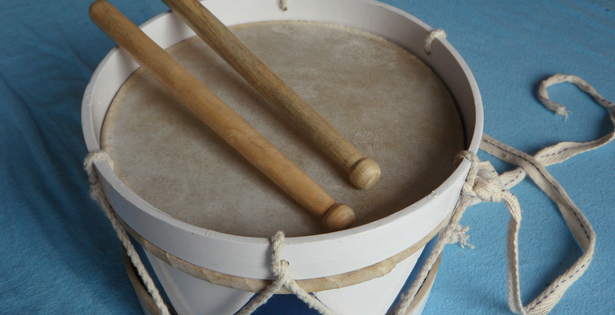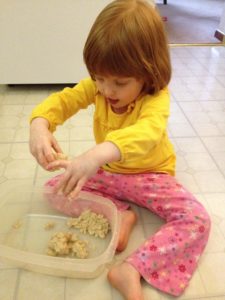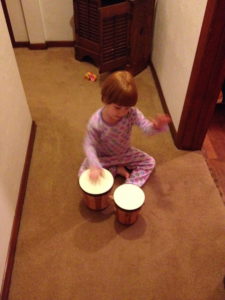
I have the benefit of looking back over a decade to see what part of occupational therapy (OT) made a strong impact. At first, it was confusing. I did not understand why it was called “occupational,” as if it has to do with one’s job. Much of what we do with fine motor skills relates to our daily activities, our work as people. It’s about adapting the tools, environment, or task to fit the person. The challenge was finding what would click for a tiny preemie.
Right out of the NICU, our daughter was referred for early intervention (EI). As a 24-weeker who was trached and ventilator and oxygen dependent, we had a three-and-a-half-foot radius to navigate. Obstacles were an understatement! I was surprised to find out how much she was “supposed” to be able to do at only six months old. She did not meet any goals for her age group, or for her adjusted age.
The specialists told me gently that Zoey would get full services because she was globally delayed. That meant she did not meet any milestones for physical, occupational, speech, nutrition and social-emotional development. So we set up a schedule and three OT goals at a time.
It was a strange shift for me to be on the receiving end of home services. Right up until my labor and delivery, I’d been a mobile art therapist. I was used to people inviting me to work in their homes on goals and measuring progress with families. Suddenly, with my own child, all of these other professionals were in the lead, and I was trying to catch up. I felt grateful to have pros from every field help her. Like most preemie parents, I also felt painfully upset that my baby needed so much help. She was labeled as “failure to thrive,” and “behind” and “globally delayed” as an infant. I felt like I wasn’t enough for her, I didn’t know how to achieve all of these goals. I saw her love of life and desire for movement.
As a parent, I learned trial and error is everything. For every weakness we personally have, we are good at something else. Other than the scribbling stages of art, I did not know the first thing about occupational therapy or fine motor skills babies needed to learn. Baby and medical care was all new to me. So I integrated what I knew with what I didn’t know – just like a child in therapy.
 I remember when the occupational therapist told me that she had tried every activity and trick she knew, but could not get Zoey to cross midline or alternate use of her hands. Her hands were supposed to “come together in play” at three – five months, and at over 12 months, it was not happening. We read over the bilateral coordination goals. The therapist explained bilateral coordination is how your hands work together in unison or separately. I had no idea what that looked like in real life. She explained: both hands come together to clap or grasp a toy. One hand holds the bowl, the other hand works the spoon. One hand holds the paper, the other hand uses scissors. In art terms, it was like two hands working to smush clay flat or roll it into a ball. It was fanning out a glob of paint from the middle of the page outward. Once I could use my own familiar examples, I figured out a way to help.
I remember when the occupational therapist told me that she had tried every activity and trick she knew, but could not get Zoey to cross midline or alternate use of her hands. Her hands were supposed to “come together in play” at three – five months, and at over 12 months, it was not happening. We read over the bilateral coordination goals. The therapist explained bilateral coordination is how your hands work together in unison or separately. I had no idea what that looked like in real life. She explained: both hands come together to clap or grasp a toy. One hand holds the bowl, the other hand works the spoon. One hand holds the paper, the other hand uses scissors. In art terms, it was like two hands working to smush clay flat or roll it into a ball. It was fanning out a glob of paint from the middle of the page outward. Once I could use my own familiar examples, I figured out a way to help.
We made edible play doh to pinch, squish, and grasp small toys out of. She painted a ton with her food and tempera, making abstract art. We used colorful blue cardstock and white paint to blend with other colors. She loved Blues Clues and the “Color” episode, so we would watch that and make our own paint mixtures. But she still needed hand-over-hand to complete these tasks. There was nothing she could practice independently. All of it required me to do set up and clean up.
While cleaning, I found my djembe, a wooden carved hand drum. I sighed, recalling my “old life”. Right before I got pregnant, I took drumming workshops with Jim Donovan (who still has online tutorials for beginners). I decided to play the way he taught me – if you mess up, smile, and keep going. I started to play along with some of her favorite songs. She soon gained interest. She wanted to try! She could make only tiny, quiet sounds at first. It became a game of getting to the center of the drum with both hands, or just one.
 Soon, we had a baby rhythm band kit and a LeapFrog drum. She could not make the letters sound or light up at first, but she was mesmerized and kept getting us to do it for her, and kept trying to make it work herself. It was a game of how many hits on the drum she could do in a row, to hear the whole alphabet. Her therapist was thrilled to come back from break to see progress. She could not believe that all it took was a few musical instruments to motivate Zoey. The therapist assured me that hand drumming – using one hand at a time, alternating, or both at the same time, counted as bilateral coordination.
Soon, we had a baby rhythm band kit and a LeapFrog drum. She could not make the letters sound or light up at first, but she was mesmerized and kept getting us to do it for her, and kept trying to make it work herself. It was a game of how many hits on the drum she could do in a row, to hear the whole alphabet. Her therapist was thrilled to come back from break to see progress. She could not believe that all it took was a few musical instruments to motivate Zoey. The therapist assured me that hand drumming – using one hand at a time, alternating, or both at the same time, counted as bilateral coordination.
Music training allows you to build skills at your own pace, and through repetition. Nearly anything can be used as a drum, so you don’t even need fancy equipment or extensive clean-up. Instruments are a solo, duet, or group activity. Drumming is a nice balance of ease and challenge. It’s fun. No matter what, you are creating sound, you are making something happen, you are expressing something about yourself – a powerful motivator for preemies who struggles to make stuff happen. When I thought about her future, I could envision her as having a love of music and being hands-on with instruments. It brought the beauty of life back into the goals and milestones.
Through art and music, occupational therapy finally made sense to me, and clicked for my 24-weeker.
